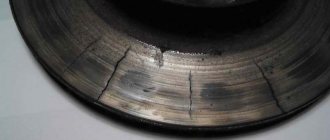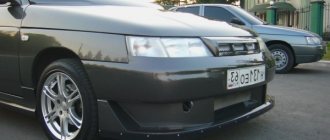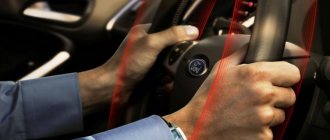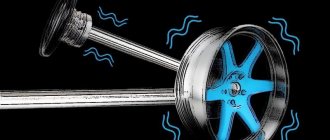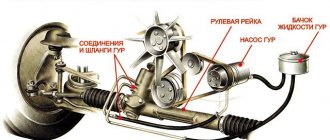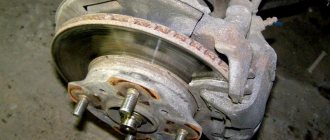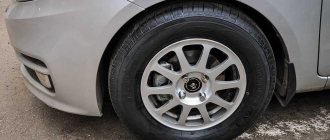Let's start from the beginning, maybe my story will help someone... I bought a car somewhere in April or May 2022! Toyota Corolla 2002 body 121 (1.5 automatic right hand drive). (let’s fly forward a little now)… July. the steering wheel began to swing like a pendulum...left - right! Before this, it seemed like this was also the case, but not so much - I didn’t pay attention, because... I bought new tires and thought it was because of the tires). But in July I went to Baikal and while I was sleeping for an hour, a friend was driving... when I woke up, I heard... “damn, how are you driving, the steering wheel is shaking unrealistically.” After that, I really began to notice that it was shaking a lot... Shaking at any speed until the car stopped, and the steering wheel did not respond to the brake pedal (it continued to move left and right). I went for balancing... they said everything was fine. I went to the breakdown... they also said buzz... trips to services began... everyone said look. RUBBER, DISCS, crooked drive shaft, internal GRENADES, brakes (discs were crooked - there were assumptions - like they hit the pad a lot) (although when braking... the car stopped perfectly), driveshaft (crosspiece), they also said the EUR is buggy. There are a lot of options... in August I already started taking action... Replacing the crosspiece... (there was a small play) - it didn’t work, I took the wheels from a friend (from a fielder), threw them on myself... - the steering wheel was beating the same way... In September I took a ride in his car and saw that the steering wheel was also running somewhere (albeit in a different way) ... I decided to change my shoes to my own winter tires, suddenly the hernia was invisible (and there would be no more heat, I just couldn’t drive with such a steering wheel anymore - I had to act ... the collapse immediately ... - ZERO result! The steering wheel kept beating left and right! Further, when inspecting the brakes, it was discovered that the right caliper was moving back and forth a lot... (on a raised car without wheels, at speed D, it was clearly visible that the disc was very crooked.) It was decided to buy two new...SATA discs. (I bought one in vain). And new pads... (purple Japanese ones, forgot the brand). I changed it... one of the discs began to beat heavily (the knocking was simply unreal, as if they were knocking with a hammer... I returned one disc. They replaced it with a new one (again, I unpacked it myself). It was crooked again... it was decided to go to a turner and sharpen it... (they removed it a little - IT WAS CURVE)... put it... perfect! But it had no effect on the steering wheel! On the same day I noticed that when the wheel and brake disc were removed... the hub was dangling in the bearing... and when the wheel was screwed on it did not dangle (the service department said that it was normal)... But my steering wheel was shaking a lot... I need to do something... I remove the hub and run to store...to the service...pressed...put it back...didn’t help. The steering wheel still turned left and right on its own... (beating). The service team came up with an idea...remove the drive and see if the grenades and the drive affect this runout. I forgot to note that even with the car raised, the steering wheel shook when turning the wheels, at speed D.
So I came to the garage and decided to remove the drive as advised (to make it clear whether the EUR or the drive and the grenade were). Of course, I didn’t unhook the drive, I lifted the car, and secured the steering rods (or rather, the tips) from the hubs... ALL torque does not affect the steering wheel in any way... I get into the car, turn on “D” and... the same thing again. But it was clear that it was not the drive or grenades... I remembered here (September) that when I bought the car, the steering rack was knocking loudly! I sent it in for repairs (I removed it myself) ... HERE I started to think, is it a rack? or is it still an EUR, as everyone says! I decided to remove the cardan (which has a cross), thereby understanding the EUR or rack... on a raised car again! BAM... without a rack, the steering wheel spins perfectly. It doesn’t shake or anything (yes, be careful so as not to break the cable...) ... you attach the cardan and everything shakes... So I thought the RACK most likely or the EUR is simply behaving correctly without tension! so there you go! On September 19th I will disassemble the rack (today). I see that the fluoroplastic bushing is somehow incorrect... without slots... and it’s very thick... the shaft moved very poorly... IF I pulled out these bushings (metal and fluoroplastic). I went to the store and bought an original bushing (then I’ll send the code to anyone who needs it) ... they are sold specifically for these rivers ... (I found out just yesterday). so here it is. I’m putting everything back together with a new bushing...(there are a lot of instructions and photo reports...how to do it, I followed them). I leave the garage at 22:00. (I went and tightened the rack a couple of times). and here it is... perfect... THE STEERING STEERING is rooted to the spot... So here's the conclusion... re-tightening the rack (worm or bushing). very bad... no one knows how the EUR will react!
How can you solve the problem?
Some will take their favorite car to a service station. However, this should only be done when there is a reliable specialist who knows his job well. Otherwise, there is simply no guarantee that the source of vibration will be detected and the problem will be solved. Even in the event of such troubles (and they occur very often), repair specialists can charge a high price for the work. The driver may also pay for unnecessary operations. For example, a service station offers to replace the entire steering mechanism completely. Doing this is much easier than figuring out why the steering wheel shakes at low speed. The owner should be well aware of the reasons for this behavior - then he will not need the help of the service. You can almost always fix the problem yourself.
Repair kit contents
If the question you are interested in is “which one to choose,” then there will be practically no recommendations here, because the design of all mechanisms in VAZ car models is almost identical. So:
- Just remember that you should beware of counterfeits when purchasing.
- And one more thing you should definitely know before purchasing a steering rack repair kit is the fact that they come in different configurations
- The simplest and, therefore, the cheapest repair kit includes only a washer, nut, and bearing, as well as fluoroplastic bushings, since bushings are consumables
- The average-priced kit is the same kit, only complete with all bearings and shafts
- And finally, the most expensive configuration option, which is used to perform major repairs, is equipped directly with a new steering rack
We have completed a detailed diagnosis of the problems, there will be another article about detailed repairs, so as not to search for it, it’s better to watch the repair video.
Balancing disorders
Tires and rims are not ideal either in terms of geometric characteristics or composition. And since the weight of these elements differs in some parts, then at the moment the wheel rotates, the point where the weight is greater will pull the center of the wheel towards itself. This is the effect of centrifugal force. Even at low speeds (and already at 40 km/h the wheels rotate quite quickly), vibrations will come to the steering wheel through the rods. Wheels must be balanced. This is done after replacing tires or wheels. The essence of the process is that the mass of the wheel is the same at each point. To do this, special weights are attached to the disk.
Vibration during acceleration VAZ 2110 8 valves
- To the beginning of the forum
- Forum Rules
- Old design
- FAQ
- Search
- Users
After warming up the engine and traveling for several kilometers, when stopping with the engine running, vibration occurs on the steering wheel, gearshift lever, body, etc. I replaced two supports on which the engine stands on the right and on the left with the gearbox. The vibration remains. The engine runs smoothly, the speed does not fluctuate. 1.5 16 valves, 2112. Help me figure it out. What is the problem and what should I change?
Symptoms of imbalance
The main symptoms are the steering wheel shaking at low speed. But vibrations can also be felt at higher speed ranges - from 60 km/h and above. It is necessary to carefully inspect the tires and wheels. The discs must be smooth and without deformation. If your driving style is calm and careful, and the tires are not too worn, then the cause is imbalance. What to do in this case? Balancing only the front wheels if there are vibrations only on the steering wheel is the wrong approach.
Diagnostics and standard causes of vibrations
VAZ 2110 vibration on the steering wheel
There may be several reasons why vibrations are observed on the steering wheel of a VAZ 2110 car. In many cases, a superficial diagnosis will not provide accurate answers, and only a competent, thorough examination will help determine an accurate diagnosis.
Brake pads
As a rule, new motorists who understand little about cars naively believe that shaking and vibration are the result of worn brake pads. Having installed new brake pads, motorists begin to understand that the reasons lie much deeper. Although, if this “disease” has not gone too far, then changing the pads also helps, but for a while. And for the most part, replacing pads with new ones is a waste of time and effort.
Discs
As for the so-called “garage” specialists, they will all say the same thing - vibrations are associated with brake discs that need to be replaced with new ones. And it is imperative to install imported brake discs, since domestic ones do not cope well with their function. What's true is true. The runout of domestic brake discs installed on a car is much greater than even that of old discs installed on an assembly line. In addition, the metal of our discs is often “raw,” so to speak, that is, it is easily affected by the brake pads and wears off.
Note. Installing new brake discs does not completely guarantee that vibrations will disappear. The fact is that the reason may lie even deeper, and changing disks will only give half the effect.
Grooving brake discs
Grooving brake discs
Usually, when a car runs more than 50 thousand km, complaints about steering wheel shaking increase. The standard diagnostic option in service centers is as follows:
- The chassis of the car is carefully checked;
- The vehicle controls are subject to diagnostics;
- The left steering tip is often replaced;
- Wheels are being balanced;
- Brake discs are either replaced with new ones or sharpened.
The question arises: why buy new brake discs, especially ventilated ones (they are not cheap), if you can simply grind them, which gives excellent results.
Attention! It is noteworthy that sharpening brake discs is not so easy. This requires the skills of a highly qualified turner, who can identify by eye the excess part of the working surfaces, which he can successfully grind off. After this, the surfaces may remain rough, but there is no need to worry about this.
Attention! The minimum permissible thickness of a ventilated disc for a VAZ 2110 is 17.8 mm, and a non-ventilated one is 10.8 mm.
Non-standard reasons
It’s interesting, but it also happens that after sharpening and installing the discs, the vibrations on the steering wheel do not disappear. In this case, an unconventional method can help - turning the hub itself on a lathe, which reduces runout.
Algorithm for grooving the hub
- A special device is attached rigidly and at the desired angle (necessarily strictly perpendicular to the plane of rotation);
- Powerful supports are placed under the car;
- The jack is removed, and the brake caliper is tied firmly to the shock absorber strut.
Note. You need to tie the brake caliper with wire and away from the lathe.
- We start the engine;
- We turn on fourth gear;
- We connect the “machine”.
Note. The chips should be thinly wound around the cutter. After one full pass, the remaining portion will be visibly visible on the hub. After the next few visits, this very “bald patch” will completely disappear.
- The hub is ground to zero.
The grenade fell apart
On a VAZ 2110, the causes of vibration in the steering wheel may be associated with a grenade, although some would-be masters deny this. Features of steering wheel vibration when a grenade is scattered:
- When accelerating, vibrations are clearly felt;
- You feel them and disappear when you coast;
- In the early stages, steering wheel vibration can be felt at speeds of 60-80 km/h;
- At low speeds vibrations are not felt;
- The car may run off the road in the later stages of this disease, especially at speeds above 100 km/h;
- In addition to the vibrations, you also feel a terrible knocking sound, and when you release the gas pedal, the vibration immediately disappears;
- Vibrations can clearly increase in proportion to the number of people in the cabin (the more people there are, the stronger the vibration);
- A strong frontal wind can also cause an increase in vibrations.
If you observe the above symptoms, you need to inspect the grenade. It is noteworthy that a CV joint defect may not be immediately noticed. You'll have to tinker a little, take the shafts with grenades in your hands and twist them, changing the angle.
Wheel balancing is the most common cause of vibration in the steering wheel.
Steering wheel VAZ 2110
Disc deformation
As already noted, they are far from ideal in their geometric characteristics. And how curved the wheels are greatly affects the behavior of the car. Wheel rims may become deformed due to the vehicle falling into a hole. Curvature can be detected visually. It is necessary to carefully inspect the rim for dents. But most often the inner part of the wheel rim is bent. Stamped products are most susceptible to deformation. Cast ones are destroyed to a lesser extent. The wheel rim may change its geometry during operation, or may be uneven initially. This is determined at a special stand. But there is a problem here - often on such equipment the wheel behaves correctly, but when driving a car it rotates unevenly. If the disk behaves this way, then it is clearly defective.
Painfully banal
If the body vibrates when accelerating, you should not be upset and immediately count out a large amount for repairs. Below are some common and not so common cases that can cause discomfort when driving:
- Dirt or ice block stuck to the inner rim of the wheel rim. Diagnosing the adhesion of dirt is not difficult, since noticeable beating will occur only after off-road driving. In winter, every driver should be prepared for such troubles;
- Incorrect installation of brake and wheel discs. If the mating plane has not been cleared of contaminants or is deformed, this will cause an increase in vibration load during movement;
- discrepancy between the landing dimensions of the wheel rims. Each disk has its own installation parameters, violation of which can lead to imbalance. This mainly concerns disc bolt patterns;
- loose disk fastenings. This is the first thing to check when you notice runout in the steering wheel. The consequences of neglecting this advice can be very dire.
There can be a huge number of possible problems with a car, and a specific breakdown does not always give specific signs of its presence. Drivers often complain about body shaking when accelerating or at a certain speed. There can be quite a lot of problems that determine this indicator. If your car has vibration during acceleration, you should look at all possible breakdowns and immediately replace the failed components.
It is not always possible to tell by the nature of the vibration where exactly the problem lies. On different cars, only the steering column can vibrate, putting it in the driver’s hands, but the entire body can shake. It all depends on the design, nature and degree of damage to the components and assemblies that need to be replaced. Let's look at the main causes of vibration during overclocking.
Tires
The steering wheel shakes when driving at low speed due to the tires, or rather their quality and condition. The cord, the metal braid that is located inside the tire, is often damaged. As a result, part of the tire becomes convex, which causes beating. Another equally popular tire problem is bumps. They appear on the sidewalls of the rubber due to careless driving, driving on potholes or rails. Well, you can’t cancel a factory defect. He can express himself in a variety of ways. If it hits the steering wheel at low speed, the problem can be solved by replacing damaged disks and tires.
conclusions
Knowing these points, the owner can independently identify the reasons why the steering wheel of his VAZ-2112 car occurs when braking or at speed. If you cannot identify the reasons yourself, you should contact a service station. Operating a car with such a malfunction is dangerous!
After using the car for a long time, many drivers stop noticing the steering wheel vibrations that occur. But sometimes such beating is a consequence of vehicle malfunctions, and if they are not corrected in a timely manner, driving safety can be greatly reduced.
Weak wheel fastening
This reason is very dangerous. If the wheel fastening becomes loose and the owner does not notice it in time, the wheel may fall off the hub while driving. The safety of the driver and passengers will be at risk. When the steering wheel shakes at low speed, the reasons are not sought here. But in vain. If this problem is not detected in time, then after a while the car enthusiast will come to replace discs, hubs, brake discs and much more. In this case, vibrations are noticeable even at very low speeds. The beats will be cyclical or acyclic. They can appear and disappear at the same speeds.
Why does it hit the steering wheel?
The reason for vibration or shock in the steering wheel may be that the steering rod joints and the mechanism itself have failed. There are also often situations when the whole reason lies in the wheels of the car. To figure this out, you should follow the rules below.
Diagnostics of brake discs and pads
Grooves and wear are visible, but you won’t be able to see that the disc has moved.
In most cases, “crooked” brake discs are to blame. People say that they were “led.” You can try to assess the condition of the disks visually, or you can use special diagnostic equipment. It will measure vibration and give an accurate verdict on the condition of the brake system and the need to replace the brake discs.
Now it’s better, but before there were a lot of fakes, and you could run into “crooked” disks even with a new part
Suspension diagnostics
When there is vibration in the steering wheel, the following actions should be taken:
- Turn the steering wheel to the right all the way. In this position of the wheels, it becomes possible to access the traction joints.
- You should check the rubber cover on the hinge. It must not be damaged. In this case, it may be necessary to replace it.
Checking the condition of the boot on the steering tip
Important! There is no need to tighten the nut that secures the mechanism to the base of the body too much . This can lead to broken studs, which are quite difficult to replace on your own. The tightening should be 16-19 Nm .
Inspection of tie rod connections
Diagnostics of the tie rod connection to the steering rack
Also, attention should be paid to those places where the rack rods and steering rods are connected . If there are gaps in them, they will need to be eliminated. If this is not done, then the steering tips will soon have to be changed. Faulty tips create an increased load on the steering rack and can cause it to fail prematurely.
Important! When the tie rod end is changed, the wheel camber/toe angle can be disrupted. Therefore, after the event, you will need to visit a service station, where this indicator will need to be brought back to normal. You won't be able to set this angle on your own.
If the inspection does not reveal the reasons why the steering wheel is beating, then the reason may be in the wheels. They may have a hernia or lack balance.
Hernia on the wheel
In this case, the tires must be changed and balanced at a service station.
About the rake
Also, the reason is hidden in the steering rack. It must be remembered that the clearances of the suspension elements themselves do not cause vibrations or beating on the steering wheel. The unfixed part becomes a catalyst. But the main problem is the wheels, and you need to start from this. The steering wheel of the VAZ-2110 also shakes at low speed due to a faulty power steering mechanism. In this case, the rack is directly connected to the rods - hence the vibrations. In this case, experienced car owners advise inserting a rubber element into the steering shaft cardan. A ball with a diameter of 22 mm made of synthetic rubber will do. But the material wears out and cracks over time. As a more durable solution, you can use a cube with a side of 20 mm from the bumper of classic VAZ models.
Steering wheel wobble at low speed and at idle
Also, difficulty with the occurrence of steering wheel vibration when turning right or left can be caused by insufficiently reliable fastening of the internal combustion engine to the car body. This leads to consequences such as:
- large feedback from the steering wheel at idle;
- vibration of the steering wheel when the car comes to a complete stop;
- deviations in the steering when starting the car;
- when squeezing the accelerator and increasing speed.
It is very simple to recognize the cause of such vibration in the steering wheel: a high-frequency beat occurs, the vibration completely depends on the number of engine revolutions. Consequently, as the speed increases using the gas pedal, the vibration becomes more frequent. The problem can also arise if the drive shaft is not operating correctly. However, this rarely happens.
Summary
If you study the malfunctions, you can derive a small rating of the prevalence of causes. So, if the steering wheel of a VAZ-2114 shakes at low speed, then in the first place are problems with the integrity of the tires and rims. For many, vibrations were caused by a hernia or a crooked wheel. Then there are breakdowns in the suspension and steering mechanism. But often the problem can be solved by a simple visit to a tire shop. And to eliminate this situation, you should brake well before each large hole and be careful when passing railway tracks. A bump on the sidewall of a tire cannot be restored.
From the ones I know: 1) Curved disks - checked, they are straight. 2) Bad tires (the wheel cord is worn out or damaged) - the tires are already bald, but not so much that there would be such beating. Yes, and the steering movement began somewhat abruptly. 3) Steering (from the tips to the play in the steering rack) - the rack is dry, does not snot, and I recently changed the tie rods and ends. And the problem was there BEFORE changing these parts. 4) Wheel balancing - I did it, the problem remained.
BUT, the main thing that I'm wondering is whether the wheel alignment can affect it? Purely logically, I can’t understand how it can influence the movement of the steering wheel from side to side? As I understand it, if there is a wheel alignment violation, then the car pulls in one direction and the tires wear out. But in the same direction, and not in different directions? Or am I missing something?
The internal grenades are loose, help!
Good day, Rescuers.
The problem is the following, I changed to Spaska 1998 Guards. AE111 dv 4A The family really liked it. But alas, there is such a problem! When driving on an uneven road, a metallic knock appears. Replaced: external grenades, links, stabilizer bushings, bushings on the levers, bumpers and boots on the struts (live struts) ball. Wasted a lot of time and money, but alas. The knock on the left front remained the same :( Yesterday I disassembled the left strut and checked it again, everything was in order, and when I started installing it, I took hold of the CV joint and felt it. Something was wrong here. I climbed under the car. I grabbed the inner grenade and shook it, there is play. Moreover, the play on the left is greater than the play on the right. The play is precisely in the place where the grenade is attached to the box. The oil seals in place do not leak any liquid. But if you shake the grenade up and down. A metallic knock appears:( I don’t know What should I do? Help, kind people, the car is very necessary every day:(
“However”... “However”
Faulty wheel bearings, loose, worn or damaged suspension parts (bushings, bushings, springs, struts/shocks, tie rods/tie rod ends) can also cause the steering wheel to vibrate when braking.
Vibrations from loose or worn wheel bearings are usually felt in the steering wheel when braking and turning at the same time.
Also be aware that, for example, a faulty wheel speed sensor can send misinformation to the car's computer, which mistakenly activates the anti-lock brake system even when braking smoothly at low speed on dry, smooth pavement.
Attention: the steering wheel should not vibrate when braking! To avoid major and costly repairs, have your brakes and braking equipment inspected when your vehicle is undergoing regularly scheduled maintenance or any repairs.
